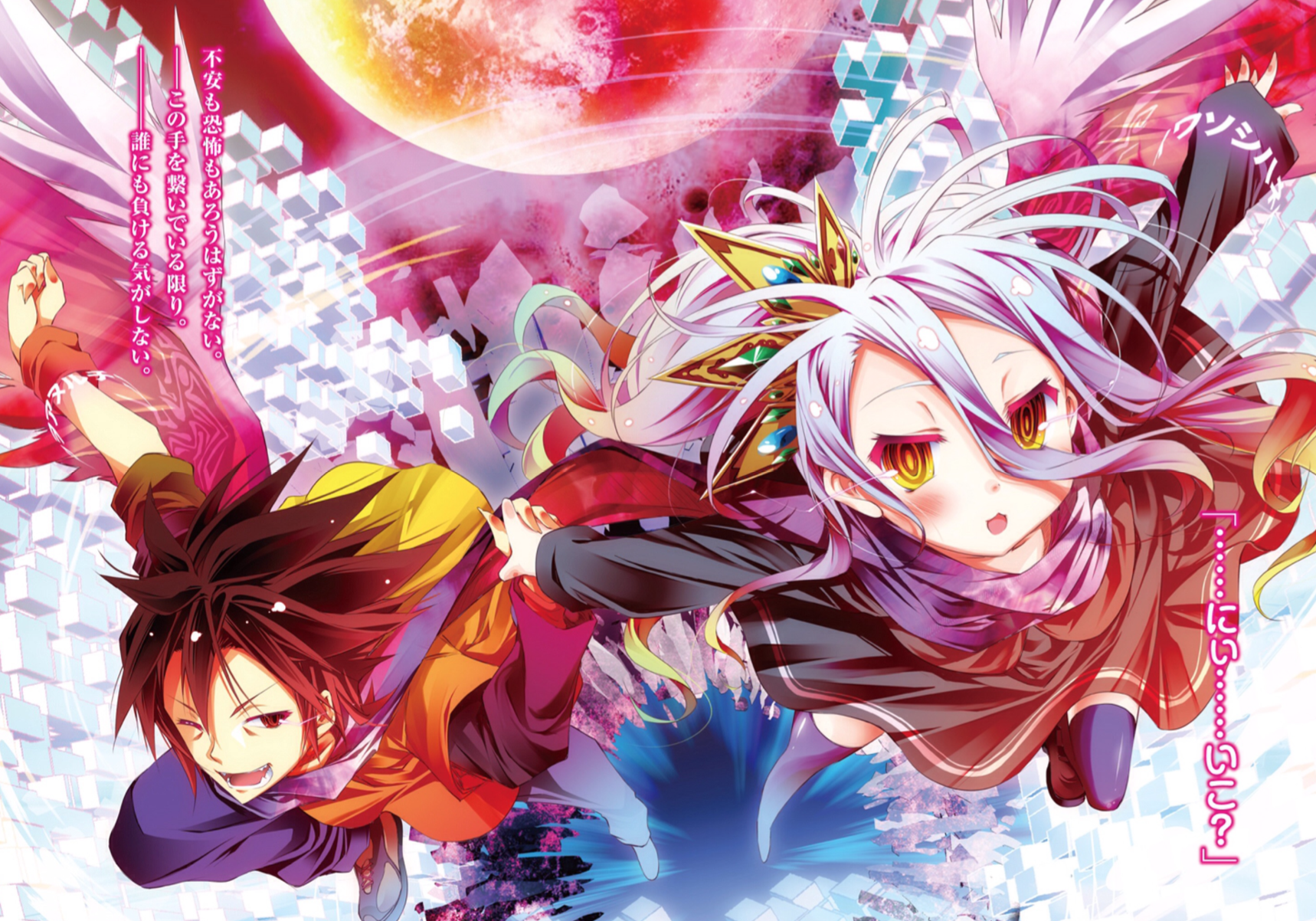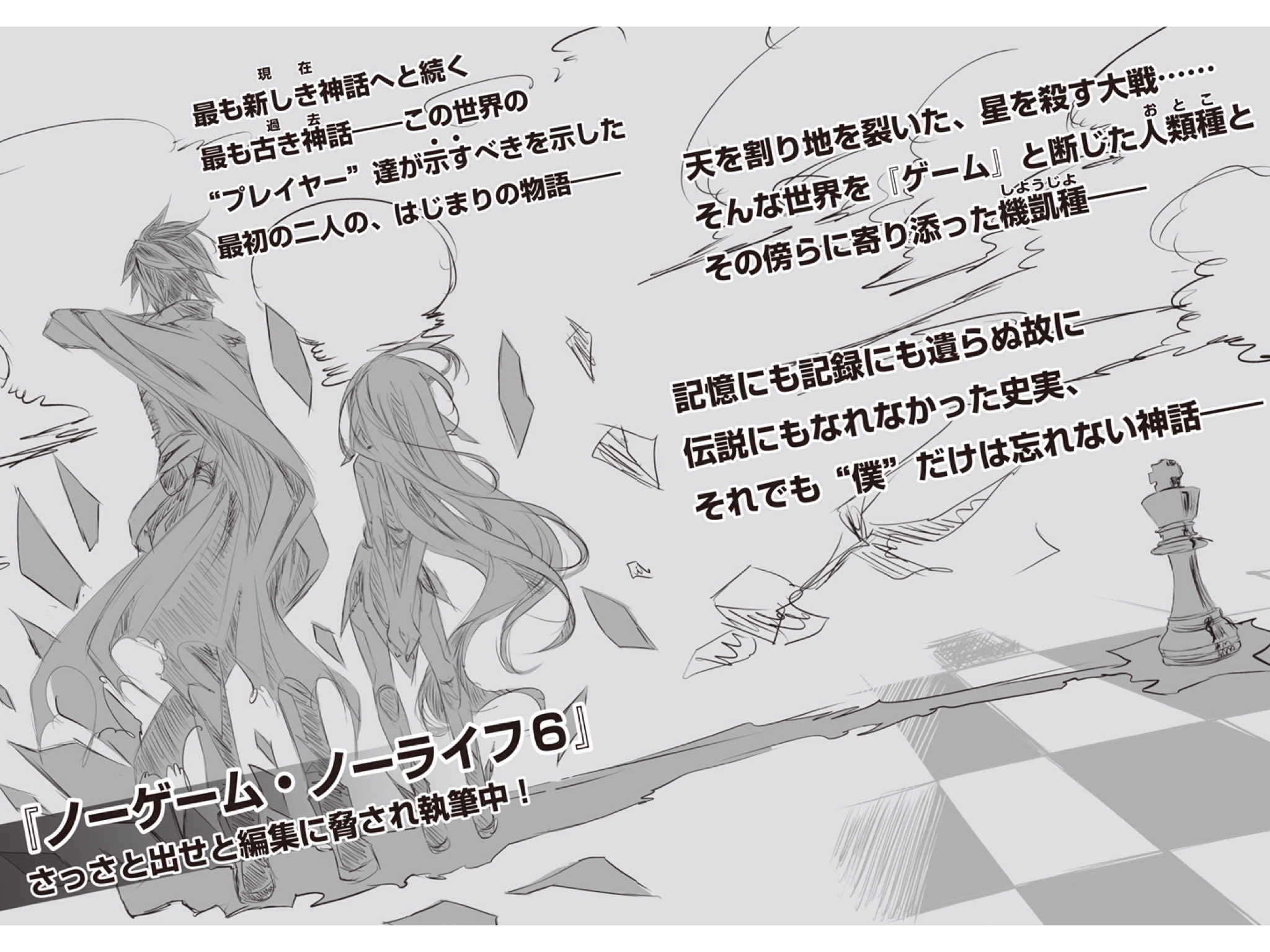After temporarily leaving the Sirens’ game, Sora and Shiro travel to Avant Heim in order to gain the knowledge necessary to beat their game. When they arrive, they quickly meet Azril, the first Flügel created, the Representative of the Winged, and Jibril’s “older sister.” Azril holds much love for her “younger sister” Jibril, so she agrees to help Sora and Shiro. But beneath that peppy exterior, is a dangerous Flügel with the intentions on bring Jibril back.

The fifth installment of No Game No Life continues where the fourth left off, with Sora and Shiro going to Avant Heim to obtain the knowledge necessary to beat the Sirens’ game. It’s at this point the novel takes off, wonderfully integrating the hidden characterizations of our cast with the many philosophical themes No Game No Life has to offer.
At Avant Heim, Sora and Shiro meet Jibril’s proclaimed older sister, Azril, and while she does give a very bubbly impression, her true intentions and character are hidden from them. So in order for Sora and Shiro to get past Azril’s complications, Jibril created an agreement beforehand, allowing her Masters to play a game of Tag Shiratori against the Flügels in order to recruit their help.
Contrary to the previous volume, the game between Sora and Shiro versus the Flügels takes up most of the novel’s content, split between the actual gameplay and side commentary featuring Azril and Jibril. In the past, Sora and Shiro have won their games against the races so far has been because they have been ahead in terms of information and planning. However this time, they are forced into a situation where with no prior knowledge which tests Sora and Shiro’s ability to adapt to the situation. The game is actually very simple; evade the Flügels for an hour using Word Spirits as weapons. But that’s not the real point of this game, as the meaning behind this game is not the conclusive victory or the method to win, but rather the lessons learned by the characters.

Through the side commentary between Jibril and Azril, we are given a short history lesson about the Flügels. In the Great War, the Flügels were created by Artosh, a member of the Old Deus, referred to as their Master. The Flügels were tools used by their Master to destroy gods, but ever since their Master died six thousand years ago and murder was outlawed by the One True God, they have continued to live. So the question is why? Why do the Flügels, the weapons without a user, continue to exist?
The uneasy gaze with a soul residing within it, and an empty puppet-like smile.
Azril gave an order to all Flügels to find the “Answer” to this question of existence. Even Azril herself wants this “Answer” to be discovered, but according to Jibril, she proclaims that she has found it through her new Masters, Sora and Shiro. As the game goes on, Azril attempts to understand what Jibril is trying to convince her what the “Answer” is and what ideals Jibril now holds, but she’s incapable of understanding. The reason for that is because she isn’t able to recognize and embrace the idea of learning from failures and the possibility of the unknown. Azril was created by Artosh with the ideal of perfection, so she wasn’t able to grasp the concept, until the moment she lost and became an imperfection. Azril’s lesson here is another callback to the hidden potential of humanity, and having Jibril explain it to her shows how much she has learned and grown from her own game against Sora and Shiro.
“The heart burns when the unknown is transformed into the known. Hotter by far, though–when the known is transformed into the unknown.”
As for the true meaning of the “Answer”, while the main component is expressed through the Flügels’ game, its application to Sora and Shiro-most notably Sora, are spread out throughout the novel. The novel frequently uses the term, “Puppets”, to describe the Flugel race, Azril, and Sora. For the Flügels, their existence as weapons lost their meaning once their Master Artosh died, resulting in a race of powerful beings that never once needed to have self-thought having to make decisions on their own. Azril is an extended case of this theme, questioning her own individual purpose on top of her closed-mindedness. As for Sora, he has already resolved his conflict long ago. So it’s up to the readers to identify how a “empty puppet-like smile” applies to Sora. Sora is perceived as an enigma and he doesn’t openly talk about himself. Instead, the side characters allows us to examine who he is through their perspective. The novel briefly touches on this topic more in the prologue and epilogue and it’s an very open way to learn more about Sora and how each individual views him as a person.

The amount of detail in the illustrations have increased, improving the character depictions and adding more flair to the character’s expressions. The colored illustrations get double pages to show off the diverse and distinct range of colors. The very last picture at the end of the book gives a small preview of Volume 6 which hints at an origin story from the time of The Great War.

In this volume of No Game No Life, there is a lot of content expressed in both its themes and narrative. On the surface, Sora and Sora play Jibril’s game against the Flűgel, finish the Siren’s game from the previous volume, and conclude the results of Plum’s manipulation game. But at the same time, the novel tells a compelling story of what it means to live, the idea of unknown potential, and the endless possibilities that await in the future. Volume 5 stands as one of the best in the series so far and I highly recommend it.
Rating: Highly Recommended
Author and Illustrator: Yū Kamiya
English Publisher: Yen Press

Pingback: No Game No Life | English Light Novels